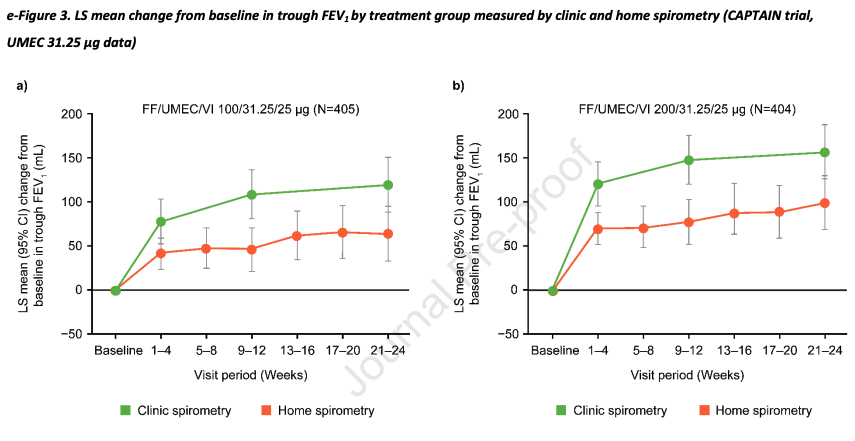
Oppenheimer J, Hanania NA, Chaudhuri R et al. Chest. 2023 Jun 27:S0012-3692(23)00935-2. doi: 10.1016/j.chest.2023.06.029. Epub ahead of print.
Abstract
Background
Studies examining agreement between home and clinic spirometry in patients with asthma are limited, with conflicting results. Understanding the strengths and limitations of telehealth and home spirometry is particularly important considering the SARS-CoV-2 pandemic.
Research Question
How well do home and clinic measurements of trough forced expiratory volume in 1 second (FEV1) agree in patients with uncontrolled asthma?
Study Design and Methods
This post hoc analysis used trough FEV1 data from the randomised, double-blind, parallel-group Phase IIIA CAPTAIN (205715; NCT02924688) and Phase IIB (205832; NCT03012061) trials in patients with uncontrolled asthma. CAPTAIN evaluated the impact of adding umeclidinium (UMEC) to fluticasone furoate/vilanterol (FF/VI) via a single inhaler; 205832 investigated adding UMEC to FF versus placebo. Trough FEV1 measurements were collected via home spirometry and supervised in-person spirometry in the research clinic. To compare home and clinic spirometry, we examined the time-course analyses of home and clinic trough FEV1, and generated post hoc Bland–Altman plots to assess agreement between home and clinic spirometry.
Results

Data from 2436 (CAPTAIN) and 421 (205832) patients were analysed. Treatment-related improvements in FEV1 were observed in both trials using home and clinic spirometry. Improvements measured by home spirometry were of lower magnitude and less consistent than clinic measurements. Bland–Altman plots suggested poor agreement between home and clinic trough FEV1 at baseline and Week 24.
Interpretation
This post hoc comparison of home and clinic spirometry is the largest conducted in asthma. Results showed that home spirometry was less consistent than and lacked agreement with clinic spirometry, suggesting that unsupervised home readings are not interchangeable with clinic measurements. However, these findings may only be applicable to home spirometry using the specific device and coaching methods employed in these studies. Post-pandemic, further research to optimise home spirometry use is needed.
